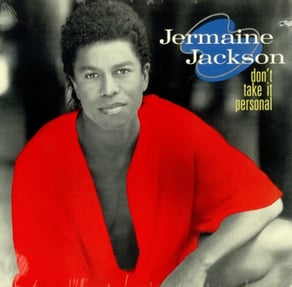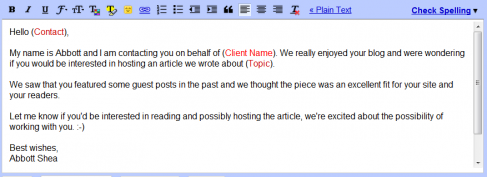Don’t Take It Personal.

In actuality I wasn’t inspired by the song, if I could I would probably change Take to Make for the sake of this blog, but the idea is the same – you don’t need to have a hyper-personalized message to get a good response rate.
There are some popular schools of thought that state an outreach message that can be tailored to each individual will give you a much higher response. I am not going to disagree with these people; they are right. But if you’re like me you’ve tried this method, sunk a good bit of your time into identifying personas and crafting the perfect message only to get the same number of responses that you were getting before – maybe even with a few more typos :-).
What I propose you do instead – and what I will explain below – is hold onto your form letters.
A Poor, Customized Template
This is an example of a guest post email template that I wrote and used to use, and probably couldn’t even boast more than a 5% response rate for.

Pretty basic, but let’s take a second to dissect this and why it didn’t work.
- The first paragraph talks about nothing but ourselves. Yawn - and we probably just lost their attention.
- In the second sentence we’re tasked with choosing a blog type that encompasses the whole blog and one that the blogger agrees with.
- Also in that second paragraph we have to come up with an attribute of the site that was “impressive”, and write about it as though we were genuinely impressed by it.
- We are not offering them anything to them, rather asking them for reassurance.
- Alright, by the third paragraph the flattery is sounding pretty cheesy.
So, granted with a tad better flow and a topic in hand it might have gotten a few more responses, the point is that even then there were more opportunities to slip up and say the wrong thing. And saying the wrong thing might still take you a lot of time to do. We are not mind readers, just nerds.
A Strong Form Letter
The two items that will elicit a response is a quality offer and a good subject line. The subject line to get them to open it, and the offer to encourage a response.
Here is an example of a short and simple outreach template that I‘ve been running with lately for guest posting.

It has been working pretty well. A 50% response rate on the relatively small sample I’ve tested it for, compared to my prior response rate of about 15% for guest post outreach.
This is the structure for almost all of my guest post outreaches; an introduction of myself and the offer, a brief explanation, and a closing line. I would make a small adjustment if I am presenting them with multiple topics.
What makes this work?
- Spend a minimal amount of time.
- Not losing anyone’s attention because of length.
- Don’t run the risk of offending anyone by saying too much or being overly flattering.
Now I can’t just leave off here else I would be cheating you all of some of the other good stuff to better your guest post outreaching – the subject line and the topic (i.e. the offer).
So here are some tips.
The Subject Line
You want to get this right, because the chance of your message even getting read depends on it. Here’s a punch list of some of my own best practices:
- Keep it short – This will help you stand out among a crowd of messages trying to explain themselves away in the subject. Also, consider a lot of these folks are reading their emails on their mobiles and a long subject line is likely to get cut off (thank you Brett).
- Make it relevant – Be straight up, don’t try to fool bloggers. They are over it. Just ask Cecily K.
- Get creative – If you can. We don’t always have the freedom to do so, depending on the client and the offer, but it does help you stand out (hint!). Some good tips in item 2 of Mike King’s post on writing better outreach.
The Topic
This is where you should spend a few minutes. Come up with a topic that relates to the blogger and their readers so that you are giving them something that would actually benefit their site. Some tips:
- Scan the site – Read through the headlines to get a sense about what people are writing about. Make notes of the comments to see what is generating the most popularity among their readers.
- Use Topsy – Wil has talked about this tool a few times. Plug in the blog URL and Topsy will tell you which blog posts have been the most popular.
- Use current events – Blogs and their readers love something that relates to what everyone is already in the news. Like, How Does The Occupy Movement Affect… A couple months too late, but hopefully you get the idea.
I hope that you all can use some of this stuff to help you get a higher rate of return for the time you put into your next guest post outreach. If you have any questions or thoughts about any of this stuff drop me a line on twitter (@abbott_shea) or in the comments below.
Thanks!

